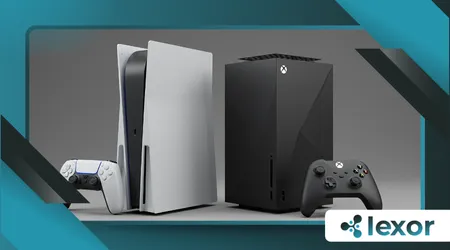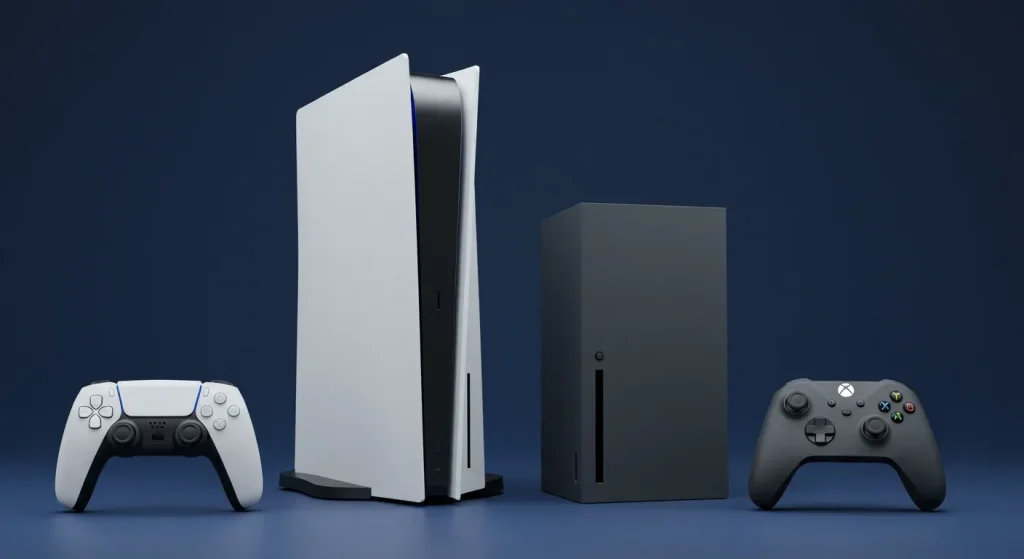Gaming Consoles of 2025: PS6, Xbox Series Z, and Beyond

The gaming industry is on the brink of a monumental shift as we approach 2025, with next-generation gaming consoles like the PlayStation 6 (PS6) and Xbox Series Z poised to redefine interactive entertainment.
These devices are not just incremental upgrades; they represent a leap into a future where gaming transcends traditional boundaries.
From cutting-edge hardware to immersive experiences, the battle for dominance in the gaming console market is heating up.
But what exactly can we expect from these futuristic machines, and how will they shape the way we play?
Let’s dive into the innovations, challenges, and possibilities that await.
The Evolution of Gaming Consoles: A Brief Retrospective
Before we explore the future, it’s essential to understand how far gaming consoles have come.
From the pixelated graphics of the Atari 2600 to the photorealistic worlds of the PlayStation 5 and Xbox Series X, each generation has pushed the envelope.
The PS5 and Xbox Series X introduced features like ray tracing, SSD storage, and 120Hz refresh rates, setting a new standard for performance.
However, as technology advances, so do player expectations.
By 2025, the PS6 and Xbox Series Z will need to deliver more than just better graphics—they’ll need to revolutionize the gaming experience itself.
The integration of cloud gaming and subscription models is another critical aspect of this evolution.
Services like Xbox Game Pass and PlayStation Now are paving the way for a future where players can access vast libraries of games without the need for physical copies.
This shift not only enhances accessibility but also encourages developers to create innovative titles that can thrive in a subscription-based ecosystem.
+ The Future of Audio: Best Speakers and Soundbars of 2025
PlayStation 6: Sony’s Vision for the Future
Sony has always been a trailblazer in the gaming industry, and the PS6 is expected to continue this legacy.
Rumors suggest that the console will leverage advanced AI to create dynamic, adaptive gameplay experiences.
Imagine a game world that evolves based on your decisions, with NPCs (non-playable characters) that learn and react uniquely to your actions.
Another area where the PS6 could shine is in its integration of virtual reality (VR).
While the PSVR 2 has already made waves, the PS6 might take it a step further with a fully wireless, high-resolution VR headset that offers unparalleled immersion.
Additionally, Sony is likely to focus on cloud gaming, allowing players to stream AAA titles seamlessly without the need for physical hardware.
Moreover, the PS6 may introduce innovative social features that enhance multiplayer experiences.
Imagine playing with friends in a virtual space where you can interact and collaborate in real-time, regardless of your physical location.
This could redefine how gamers connect and share experiences, making gaming a more communal activity.
Table 1: Expected Features of the PS6
| Feature | Description |
|---|---|
| AI-Driven Gameplay | Adaptive worlds and NPCs that learn from player behavior. |
| Next-Gen VR | Wireless, high-resolution VR with haptic feedback and eye-tracking. |
| Cloud Integration | Seamless streaming of games via Sony’s cloud platform. |
| Backward Compatibility | Full support for PS4 and PS5 titles. |
Xbox Series Z: Microsoft’s Bold Leap Forward
Microsoft’s Xbox Series Z is shaping up to be a formidable competitor.
Building on the success of the Xbox Series X, the Series Z is rumored to feature a modular design, allowing users to upgrade components like the GPU and storage without replacing the entire console.
This approach could extend the lifespan of the device and appeal to tech-savvy gamers.
Another key focus for Microsoft is the integration of Xbox Game Pass.
By 2025, the service is expected to offer an even more extensive library of games, including day-one releases from major studios.
The Series Z might also introduce a hybrid gaming model, combining local hardware power with cloud-based processing to deliver ultra-high-fidelity graphics.
Additionally, Microsoft is likely to enhance its focus on cross-platform play, allowing gamers to connect with friends regardless of their console choice.
This could foster a more inclusive gaming community, breaking down barriers that have traditionally separated players.
As the gaming landscape evolves, such initiatives will be crucial for maintaining player engagement and satisfaction.

Table 2: Expected Features of the Xbox Series Z
| Feature | Description |
|---|---|
| Modular Design | User-upgradable components for longevity and customization. |
| Hybrid Gaming | Combines local hardware with cloud processing for enhanced performance. |
| Expanded Game Pass | Access to a vast library of games, including exclusive day-one releases. |
| Cross-Platform Play | Enhanced compatibility with PC and mobile devices. |
Beyond PlayStation and Xbox: The Rise of New Competitors
While Sony and Microsoft dominate the conversation, other players are entering the fray.
Companies like Google, Amazon, and even Apple are investing heavily in gaming technology.
Google’s Stadia, though initially met with skepticism, could evolve into a serious contender by 2025, especially if it addresses latency issues and expands its game library.
Similarly, Amazon’s Luna and Apple’s rumored gaming console could disrupt the market with unique features.
For instance, Apple might leverage its ecosystem to create a seamless gaming experience across iPhone, iPad, and Mac devices.
These newcomers could force Sony and Microsoft to innovate even further, benefiting gamers in the long run.
The entry of these tech giants could also lead to more diverse gaming experiences, catering to different audiences and preferences.
As competition increases, gamers can expect more innovative features and better pricing strategies, making gaming more accessible for all.
For more insights on the impact of new competitors, check out The Verge.
The Role of AI and Machine Learning in Next-Gen Consoles
Artificial intelligence (AI) and machine learning (ML) are set to play a pivotal role in the gaming consoles of 2025.
Beyond enhancing graphics and performance, these technologies could revolutionize game design.
For example, AI could generate entire game worlds procedurally, ensuring that no two playthroughs are the same.
Moreover, machine learning algorithms could optimize game difficulty in real-time, tailoring challenges to each player’s skill level.
This would make games more accessible to casual players while still providing a tough challenge for veterans.
The integration of AI could also lead to more realistic NPC behavior, creating deeper emotional connections between players and virtual characters.
As these technologies advance, we may also see personalized gaming experiences that adapt to individual player preferences and play styles.
This could enhance engagement and satisfaction, making each gaming session feel unique and tailored to the player.
The Environmental Impact of Next-Gen Consoles
As gaming consoles become more powerful, their environmental footprint is a growing concern.
The production of high-performance hardware requires significant resources, and the energy consumption of these devices can be substantial.
By 2025, both Sony and Microsoft will need to address these issues to appeal to environmentally conscious consumers.
One potential solution is the use of sustainable materials in console manufacturing.
For instance, the PS6 and Xbox Series Z could incorporate recycled plastics and metals.
Additionally, energy-efficient designs and renewable energy-powered data centers for cloud gaming could help reduce the overall environmental impact.
Furthermore, companies may need to implement recycling programs for old consoles, encouraging responsible disposal and minimizing electronic waste.
By prioritizing sustainability, gaming manufacturers can not only reduce their environmental impact but also attract a growing segment of eco-conscious consumers.

The Future of Gaming: A Convergence of Realities
The gaming consoles of 2025 won’t just be about playing games—they’ll be about creating experiences.
Augmented reality (AR) and virtual reality (VR) are expected to play a significant role, blurring the lines between the digital and physical worlds.
Imagine playing a game where your living room transforms into a battlefield or a fantasy realm, all through the lens of AR glasses.
Furthermore, the integration of social features could make gaming more collaborative and interactive.
Platforms like PlayStation Network and Xbox Live might evolve into virtual spaces where players can meet, socialize, and even attend virtual events.
This convergence of realities could redefine what it means to be a gamer.
As these technologies develop, we may also see the emergence of new genres that leverage AR and VR, offering fresh gaming experiences that engage players in unprecedented ways.
The potential for social interaction and community-building within these virtual spaces could enhance the overall gaming experience.
++ Smart Kitchen Gadgets That Will Revolutionize Cooking in 2025
Challenges Ahead: What Could Go Wrong?
Despite the excitement surrounding next-gen gaming consoles, there are challenges to consider.
One major concern is the rising cost of hardware.
As consoles become more advanced, their price tags could become prohibitive for many consumers.
Balancing innovation with affordability will be crucial for Sony and Microsoft.
Another issue is the potential for increased digital dependency.
With more immersive gaming experiences, there’s a risk of players becoming overly absorbed in virtual worlds.
Developers and manufacturers will need to promote healthy gaming habits and ensure that these technologies are used responsibly.
Moreover, addressing issues related to online safety and harassment in gaming communities will be essential as social features become more prominent.
Creating a safe and inclusive environment for all players should be a priority in the development of next-gen consoles.
Conclusion: A New Era of Gaming
The gaming consoles of 2025—whether it’s the PS6, Xbox Series Z, or a surprise entrant—promise to deliver experiences that were once the stuff of science fiction.
From AI-driven gameplay to immersive AR and VR worlds, the future of gaming is bright.
However, as we embrace these advancements, it’s essential to address the challenges they bring, from environmental concerns to the social impact of digital immersion.
One thing is certain: the gaming industry is evolving at an unprecedented pace, and the next generation of consoles will play a pivotal role in shaping its future.
As players, developers, and manufacturers, we stand on the cusp of a new era—one where the boundaries of reality are limited only by our imagination.
References:
- Newzoo’s 2023 Global Games Market Report highlights the growing demand for immersive gaming experiences and the increasing role of cloud gaming.
Tables:
- Expected Features of the PS6
- Expected Features of the Xbox Series Z
By 2025, gaming consoles will no longer be mere entertainment devices—they’ll be gateways to new realities.
The question is, are we ready to step through?
